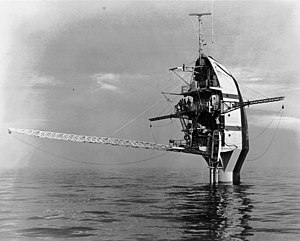RV FLIP
 |
|
| History | |
|---|---|
|
|
|
| Owner: | Office of Naval Research |
| Operator: | Scripps Institution of Oceanography |
| Builder: | |
| Cost: | Approximately US$600,000 |
| Launched: | 22 June 1962 |
| Completed: | 23 July 1962 |
| In service: | September 1962 |
| Identification: |
|
| Status: | Operational |
| General characteristics | |
| Type: | Research platform |
| Tonnage: | 700 GT |
| Length: | 108 m (355 ft) |
| Beam: | 7.93 m (26.0 ft) |
| Draught: |
|
| Installed power: |
|
| Propulsion: | None |
| Speed: | Towed: 7–10 kn (8–12 mph; 13–19 km/h) |
| Endurance: | 35 days |
| Capacity: |
|
| Complement: | 5 crew, 11 researchers |
R/P FLIP (FLoating Instrument Platform) is an open ocean research platform owned by the U.S. Office of Naval Research (ONR) and operated by Scripps Institution of Oceanography. The platform is 108 meters (355 ft) long and is designed to partially flood and pitch backward 90°, resulting in only the front 17 meters (55 ft) of the platform pointing up out of the water, with bulkheads becoming decks. When flipped, most of the ballast for the platform is provided by water at depths below the influence of surface waves, hence FLIP is stable and mostly immune to wave action similar to a spar buoy. At the end of a mission, compressed air is pumped into the ballast tanks in the flooded section and the platform, which has no propulsion, returns to its horizontal position so it can be towed to a new location. The platform is frequently mistaken for a capsized ocean transport ship.
The Marine Physical Laboratory of Scripps Institution of Oceanography created FLIP with funding from the Office of Naval Research and the assistance of the commercial naval architecture firm The Glosten Associates.FLIP was originally built to support research into the fine-scale phase and amplitude fluctuations in undersea sound waves caused by thermal gradients and sloping ocean bottoms. This acoustic research was conducted as a portion of the Navy's SUBROC program. Development started in January 1960 after a conversation between MPL researcher Frederick H. Fisher and MPL Director Fred N. Spiess regarding stability problems that Fisher was encountering when using the submarine USS Baya (SS-318) as a research platform. Spiess recalled a suggestion from Allyn Vine that upending a ship might make it more stable, based on Vine's observation of a Navy mop floating in waves. Fisher was subsequently assigned to work on the feasibility and later development of such a vessel. The Gunderson Brothers Engineering Company in Portland, Oregon, launched FLIP on 22 June 1962. In 1995, FLIP received a US$2 million modernization.
...
Wikipedia
